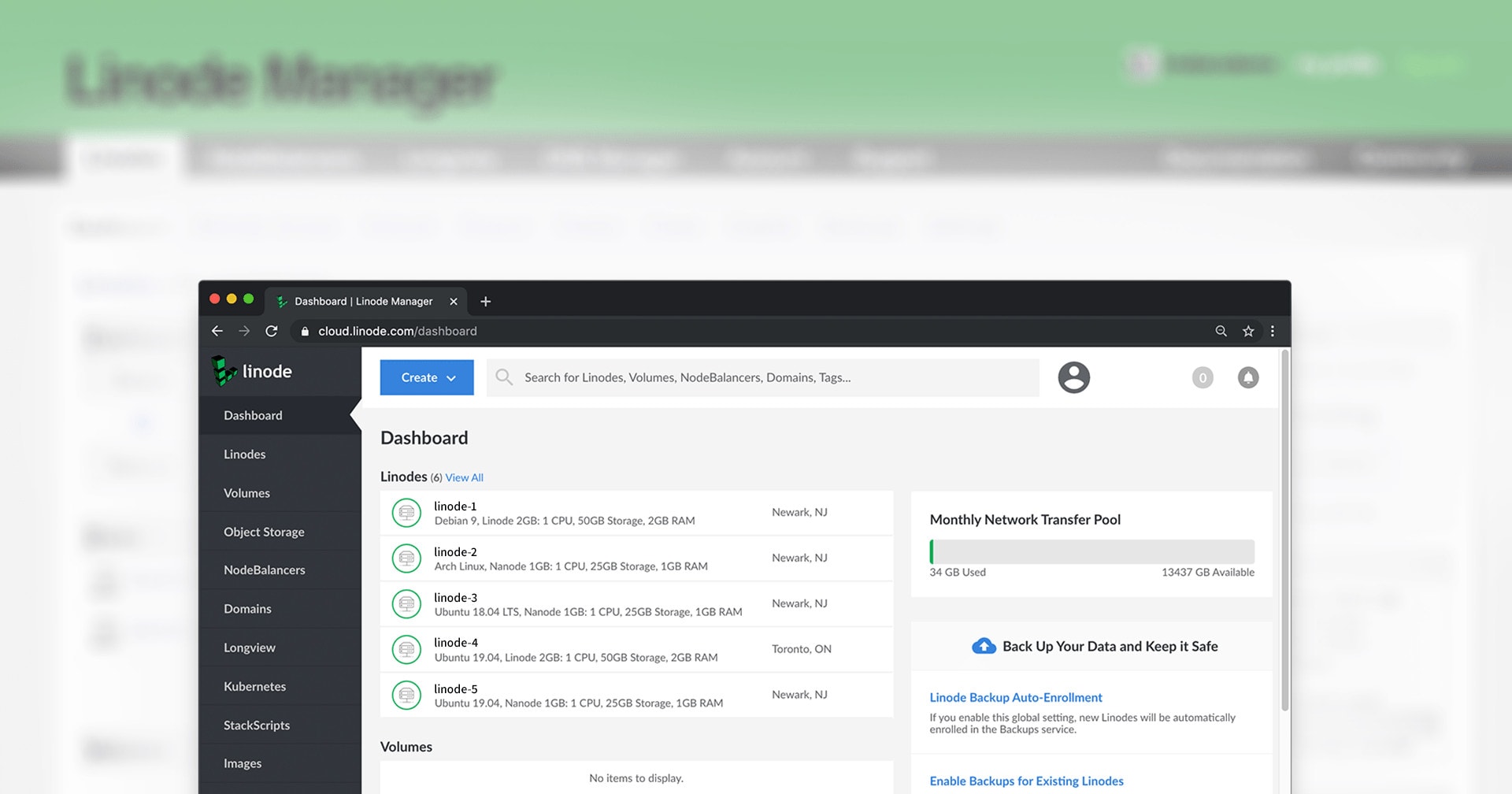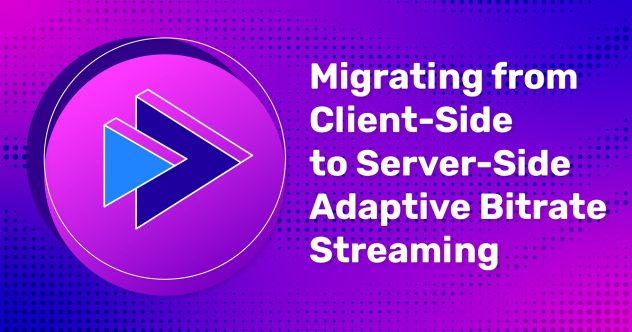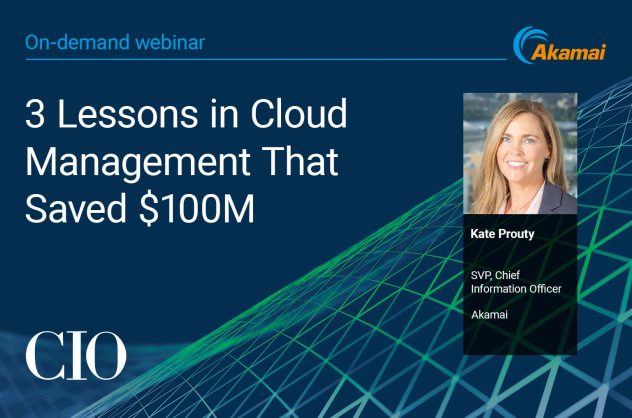La versión anterior de Linode Manager será dado de baja el 31 de enero de 2020. Después de ese tiempo, se le redirigirá automáticamente al Administrador deCloud cuando inicie sesión para gestionar su infraestructura en Linode.
Como valioso cliente, queremos que esta transición sea lo más suave posible. Muchas de las funciones disponibles actualmente en Classic están disponibles en la nueva interfaz Cloud Manager .
La monitorización de Longview no está disponible actualmente en Cloud Manager. Nuestros planes son realizar la transición de esta función antes de enero de 2020. Además, aunque han quedado obsoletas, la APIv3 y la basada en la APIv3 CLI seguirán estando disponibles después del 31 de enero de 2020.
Se han realizado importantes actualizaciones en Cloud Manager desde que se presentó en 2016. Cloud Manager tiene muchas características nuevas, incluyendo un aspecto y sensación actualizados, una interfaz de usuario moderna, soporte móvil y un fácil acceso a nuestros productos recientemente lanzados. También se ha implementado únicamente sobre nuestra APIv4 pública.
Novedades en Cloud Manager:
- Etiquetado mejorado
- Búsqueda avanzada
- Controles de acceso de usuarios
- Código abierto, interfaz de usuario
- Temas personalizados: Modo oscuro y modo compacto
- Aplicaciones One-Click
- Almacenamiento debloques y objetos
- Linode Motor Kubernetes (Beta)
- Cortafuegos en la nube (próximamente)
Si tienes alguna pregunta o duda, no dudes en dejar un comentario aquí y estaremos encantados de atenderla. Como siempre, los comentarios sobre Cloud Manager o cualquier otro aspecto de nuestra plataforma son bienvenidos en https://www.linode.com/feedback/.









Comentarios (78)
There is one main reason I have not been using the new cloud manager.
Server groups!
I know I can add tags in new cloud manager, however I have to manually add such tags.
The problem is that I have several accounts and I have lots of groups in those accounts. Such grops do not exist in new manager.
It would be great if legacy groups were automatically converted into tags.
Is it possible? You would save us a lot hours of work
Hibam Iru Dionisio Alor This is already available! You can import Display Groups from the main Cloud Manager dashboard. There’s more info here:
https://www.linode.com/docs/guides/tags-and-groups/#importing-groups-as-tags
Adding swap is more annoying than ever , still creates a small 512 MB swap, but i can no longer resize volumes without shutdown, downsizing root volume etc. At least with old i could create a smaller root volume at node creation
Hi, Sandor! This is a feature that is on our radar, and I’ve added your request to our tracker. In the meantime, when you create a new Linode, you can deploy it without a distribution image and then manually create your disk from the Advanced tab. This Community site post goes into this a bit more.
Sadly, i don’t think that helps me much. I work with multiple client accounts, so having images/configuration profiles per client doesn’t help much ( i can’t share images/profiles between clients, so would have to redo them manually, but especially when you create a node per client, is just even more extra work, without real payout .
Hi Sandor! I can totally understand how inconvenient this currently is, and I’ve made sure to include your feedback on our internal tracker. I did some more research, and you may have an easier time deploying Linodes with custom disk sizes by using the Linode CLI. I just tested this out and you can make this specification during creation by using the “–swap_size” option. You can also achieve the same results using the Linode API.
The thing that keeps me going back to the classic interface is zone-related functionality in the domain manager, and they still aren’t supported as I write this.
https://i.imgur.com/rVbMcz7.png
https://i.imgur.com/oqMdPJ8.png
Will this functionality be implemented before classic is decommissioned?
Hey Dave – this will be done before end-of-life, but not exactly as you’d expect.
Currently as it is in Classic Manager, there’s a possibility that there will be a discrepancy between the zone information available through a dig command and what’s in the Manager – mainly because the zone information isn’t being updated as fast as it would be on the server.
That being said, Cloud is going to have some information around performing the terminal commands to get this information, rather than having the possibility of having outdated information in the user interface.
This discrepancy is only for 10-15 minutes after updates. 99% of the time there is not going to be a discrepancy – because I’m not updating records 99% of the time! When there is, it’s due to propagation from root servers. I fail to see how this would prevent you from keeping feature parity here, and I also can’t understand how you’re going to have accurate info in ‘the console’ but not in Cloud?
I’ve also never used dig to get the zone file or check it – off the top of my head it seems like I’d need to initiate a zone transfer, and that seems like a really bad workaround for functionality that just didn’t get implemented in the shiny new interface.
You make some great points that the team certainly considered. While the zone file isn’t available through the Cloud Manager, the provided dig command will display what our nameservers are serving for similar verification. This doesn’t require propagation or a zone transfer, although it may take a few minutes for our nameservers to update. Cloud Manager doesn’t offer a check zone button, but does offer the ability to check every field of the zone as you enter it. This was also available in Classic Manager. We’re always looking at long term solutions and improvements that best fit customer needs. If you have a specific use case for getting and checking the zone file as a whole that isn’t possible with our current plans, we’d love to hear about it. You can always send us information to help us stay informed about what’s most important to you to feedback@linode.com.
What dig command have you provided?
I find it quite disappointing that Linode’s position is that I should have to provide use cases for current functionality, in order for you to provide feature parity in the new UI.
While it isn’t intended to replace the check zone feature, this command can assist in viewing nameserver reports to assist in troubleshooting:
dig +nocomments +nocmd @ns1.linode.com +multiline +nostats
We understand your disappointment. The more details you can provide, the better we can communicate your feedback.
I will use the old manager as long as I can because it is faster, less wasteful of screen space, and provides more fine-grained information. The new one requires a lot more clicking, scrolling, and waiting for things to load.
Hi Matt – I’m a developer on the user interface team. Is there any concrete examples of where you’d expect the app to be more detail-heavy?
Getting to a happy medium between information-overload and pages with too little information is definitely easier said than done, and we’d love any thoughts you have.
In the past, we’ve been extremely receptive to this feedback, and would love to pinpoint the crucial pieces of information users need to see at a glance.
The slowness, the extra clicks, and the wasted screen real estate are each more important than any issue of missing details, so missing details shouldn’t be the focus.
That said: the usage graphs look like they have lower resolution in the time dimension. On careful comparison of the same graph in the old and new interfaces I’m not absolutely sure that that is a real effect; it may be that they are the same resolution and just styled differently so that it looks like the new graphs are rounded off. Still, there is at least the difference of the vertical grid lines having been removed, which makes it hard to know when things happened. The new pop-up on mouse-over of the graph, which seems like it might have been created to address that problem, is annoying and not an improvement.
I don’t have an example visible to check at the moment, but last time I migrated a node from one data centre to another, I was disappointed that the new interface wouldn’t give me any indication of speed or progress on the migration operation like the old interface did. Since I did end up having a serious problem with the speed, that omission made it hard to debug. At the time I’d been trying to do everything in the new interface as a matter of good citizenship, but that was the last straw to change my policy to “old interface as long as I can.” Activity log entries in general no longer list the amount of time they took, which is useful information readily visible in the old interface.
Thanks for all this – I agree on all these points that the UI could be improved.
Regarding the activity feed “time taken,” this is something we hear a lot about and it’s definitely on the roadmap. Missing pieces of information like this are usually due to the fact that Cloud is client-side rendered, so we rely very heavily on our APIv4 to supply us with that information. As soon as the backend work is completed there, it should be a quick fix to get it into the interface. I don’t have any solid timeline on when that will be released.
Regarding the graphs, I’m not seeing different time resolution on my end, but I will say that you will need to make sure your timezone is set in both Classic and Cloud because both sites aren’t aware of each other’s timezone preferences. So if you haven’t set your timezone in Cloud yet, you might be seeing different time ranges for your graphs. You can set your timezone at cloud.linode.com/profile/display
As for the migration, I agree it’s lacking the info that Classic supplies. We do estimate the time it will take to migrate once the migration begins, and this information can be found in the header section when initiating a migration at cloud.linode.com/linodes/:your-id-here/migrate. This is also something we’re definitely iterating on as well.
All in all, we appreciate the concerns.
Just want to second that the old interface is much, much faster and I’m disappointed you’re considering decommissioning the old one before new one is at least in the same ballpark.
I’m not going to ask you to keep it around forever, but can you give us a few more months until the new one gets speed improvements?
Thanks.
Just as one comparison.
The classic manager takes 1 second to load the settings page for a Linode.
The cloud manager takes 10 seconds while it loads the 70+ resources.
That feels like eternity when you’re trying to fix something and a customer is waiting.
We all understand that new software takes a while to get the same performance.
But can you please get it down to the 2-3 seconds load time range?
I don’t care how good it looks, I care whether it lets me do the basic task I need to do while I work down my checklist of 1000 things to do every day.
Thank you.
Hey, TT. These are really good, quantifiable examples. In terms of a 2-3 second loading time, I’ve personally passed this along to our team, and they are already looking into a working solution.
Regarding the time frame for decommissioning you mentioned: I can’t promise an extension, but the speed improvements are coming soon. This is feedback that we’ve gotten from a few customers, and we are actively working on it.
In the meantime, if you haven’t tried it already, I would recommend checking out the Linode CLI if speed is what you’re after:
Using the Linode CLI
Thanks again for the great feedback.
TT,
We are working to improve the performance of Cloud Manager and will have improvements in place before we decommission the Classic Manager.
Could you please email feedback@linode.com or open a support ticket referencing this blog comment so that we can take a look at your account and better understand what is causing the slowness for you.
Thank you for the feedback.
Oh yeah – and we also should have some UI updates to the graphs going out in the next release
I have to agree with this one. The old interface was simple and to the point. The new one is needlessly convoluted and slow. This reminds me of the the FreeNAS Corral disaster.
We appreciate your feedback regarding the differences between Classic and Cloud Managers. Our team is working consistently to improve the Cloud Manager interface based on the feedback we receive. Could you provide some more information about why you find the Cloud Manager to be convoluted? As Marty mentioned earlier in this thread, we’re working to improve the user interface and would love any additional comments you have to help us fine-tune our changes. You can also send suggestions to feedback@linode.com .
I can not agree more on this . If the developer is looking at this thread. please make sure we can see all my nodes without need to scroll down. the current cloud manager is bring too much detail information at first level view. which makes the page hard to locate my node. just take the classic manager information given would be nice.
Victor: not just the developer, but several Linode employees are looking at this thread. If you haven’t tried it yet, I recommend using the Compact view, which you can activate by clicking on the gear on the lower left of the screen in Cloud Manager. I understand that this may not bring all of your Linodes into view but hopefully helps.
We are taking this feedback very seriously while our team works to bring parity to Cloud Manager. Development of Cloud Manager will continue beyond the EOL for Classic Manager. Feedback like this will go a long way to help inform future iterations, though I can’t promise all suggestions will be implemented. If you have any additional insights you’d like share, feel free to contact us at feedback@linode.com.
I completely agree. I am extremely upset that they close a convenient tool.
Classic is simple, effective and powerful. Quite unhappy with the direction you are going in. IF IT AIN’T BROKE, DON’T “FIX” IT.
Thank you for sharing your thoughts, Alejandro. Customer feedback is valuable, and this isn’t the last stop in updates to the new interface. Could you provide specific suggestions in regards to improving Cloud Manager?
How much data does the cloud manager use when on mobile as opposed to the simpler classic Linode Manager?
We haven’t run any official benchmarking tests regarding mobile data usage, but we have been working to make Cloud Manager more performant by reducing the amount of round-trips to the server by requesting more information on initial page load. Along with that, Cloud Manager is a single-page app, meaning that all necessary JavaScript assets are requested from the server initially, and are responsible for generating the markup on the browser, rather than needing to request individual assets while navigating around.
I have been kinda getting into the new interface, but please reach feature/function parity before you schedule the original portal closure.
DNS Check Zone was mentioned above, is really important. One of my users ended up having to open a support ticket for an update not happening. If he had have been using the original manager, the error would have been apparent.
Annoying thing, linode status in clould manager seems to take forever to reflect status change when a linode has been shutdown internally.
Thumbs up beyond that, and big thanks for reaching a DC in Sydney.
Hey Dathi, thank you for taking the time to share with us. It’s important to us to know what’s important to you. We’ve passed your request for feature parity along for consideration as we make improvements to the platform.
I tried the new manager once and it was painfully slow, and broken, and buggy. I’m going to take a wild guess and assume you’re using the latest, trendiest version of the React/Zuckerberg frontend stack, or whatever. That means any attempt to fix a bug will create new bugs. Slow and broken is the trend but it is not a good trend. Please reconsider abandoning working software.
Are you still running into issues with the Cloud Manager? If so, please send us specific examples of what you’re experiencing in a Support ticket so we can work to fix them prior to the Classic Manager’s EOL.
While the new manager “works”, it is not as effective and “to the point” as the old one. As a long time costumer of yours I will NOT be happy with this change. Even Azure feels friendlier and quicker than the new interface you are trying to push down everyones throats.
Thanks for providing your feedback, Noe. We are constantly improving our services, and we appreciate customer feedback. Do you have any specific feedback in regards to the “friendliness” of the new interface? I want to add it to our internal tracker for consideration.
But the new site requires javascript. The old one didn’t. That was your main feature that beat digital ocean, as far as I’m concerned. Now where will I go to get virtual private hosts, without needing to run proprietary software in my browser?
If you prefer not to use the graphical interface, we have API endpoints for each interaction that can be performed in Cloud Manager. You can also interact with your services using the Linode CLI. Documentation for our CLI can be found here and information about the API is available here.
Migration Guide, please? Is there a web page or document that can explain how tasks in the old interface can be accomplished in the new? My routine for upgrades has been to duplicate the OS disk image, upgrade the old and keep the new for rollback in case of incompatibilities. “Disks” was directly available by clicking on “Linodes.” Now, after flailing around for a while, I found Disks hiding under “Advanced.” I’m not sure what’s advanced about it. IAC, is there a 1:1 correspondence doc so I know how to find the old in the new?
That’s a great question, Ted. Our documentation is updated to reflect the instructions for Cloud Manager, but you raise a good point regarding a centralized source of information for the more common Manager uses. We’ve passed your feedback along to our team.
I don’t get the universal wish to have a new ‘modern’ interface… Linode are not the only company doing this… and they’re not the only company that end up with an interface that is anti-efficient. Specific example… the commonest job I have to do through the Linode interface involves doing ‘something’ to an existing Linode. In the classic interface, I sign on and then can use the mouse wheel to scroll a compact list and select the node I want. New interface, I sign on and then almost always click to ‘View all’ and wait for the new screen to populate and then scroll a list that is very much less compact before clicking the relevant node. So one extra click, some waiting and some extra scrolling each time I access a node… and the whole new interface feels like this, designed to slow things down. Some features are improvements, but the whole ethos of the new interface seems to be towards inefficiency.
Hey Matthew – we’re absolutely open to suggestions on how to help improve our customers’ workflow, and we definitely don’t want to slow you down. I’ve passed along and documented your feedback, but in the meantime, I would suggest trying out the search bar at the top of the Cloud Manager’s Dashboard to see if that helps speed things up for you. 🙂
Is there any way to view the amount of credit remaining using the new interface? It’s possible to see this in the classic manager, but there’s no way to see this information in the new interface. I always prefund my account, so being able to see this is pretty important.
You can see the amount you have in available credit through the Cloud Manager by clicking on `Account` from the main menu.
On the right hand side of the screen it takes you to, you’ll see a section marked ‘Billing Information.’ If you have credit stored on your account, it’ll appear (in green and in parentheses) in the ‘Current Balance’ field.
We have over 200 linodes with backups enabled and the new inteface cannot handle them. It crashes every time and is unable lo load the linodes. I am extremely worried we won’t be able to manage our account any longer, which would be an absolute disaster.
I have opened several tickets on this matter and still have no clear response. I am extremely worried.
Hi Alejandro, we’ll be responding your latest update shortly. Our Developers are in the process of implementing a fix related to your issue, and we’re confident that we’ll have this problem resolved before the Classic Manager is turned off in January.
wish you guys wouldnt move forward on this, i still prefer classic.
We would love to hear what you appreciated so much about the Classic Manager, as we continue to develop the Cloud Manager so that it meets your needs. You can always send those thoughts to feedback@linode.com for us to review.
I can’t wait for the Single Page App craze to die. Too many websites rebuild as an SPA just to make things so much worse. The classic manager is easier to manage, and provides more functionality, although it’s slowly catching up. It sounds like the zone files will never be implemented though, and who knows what else. Linode is catering to technical people. Not sure why it has to look like a non-technical web app.
Thanks for the input, Bo. We’re paying close attention to feedback regarding zone file features in Cloud Manager. There’s still time for us to make decisions and revisions, so please continue to share your thoughts with us here or at feedback@linode.com.
Not a fan. The increased white space and font size means that efficiency has been sacrified for looks. It’s not as compact as the classic manager, things that on a 15″ laptop would fit on screen are now below the fold, long list of items are not as convenient to work with, etc. For new customers it’ll probably be great, but for people with a large number of nodes and subdomains this isn’t an upgrade :/
Hi Jose! We want both new and old customers to enjoy Cloud Manger, and your feedback is really important to us. So, I’ve passed it along to our team. We’d love to hear any additional feedback you have, and you can share those thoughts at feedback@linode.com
Really sad to see Manager go – it was efficient and easy-to-use. The new system seems to use lots more screen space even on a UHD monitor.
Wish you would consider running both interfaces and if that isn’t possible, try to compact the data on the screen – e.g. DNS domains used to be in a long list that was fairly closely spaced. The new Domains have lots of white space between each entry. One click was required to edit a domain, now two are required in a huge menu on the right.
Hope this helps
Jeff
We’re happy that you had a good experience with our Classic Manager, and we want to be sure that ease-of-use carries over to the Cloud Manager.
Have you tried Compact Mode? You can access it through the gear wheel under the main menu of your Dashboard. It eliminates a lot of that white space you mentioned.
I’ve passed along your suggestions to our team to take a look at. We always love getting feedback from our users, and you can also send your ideas to feedback@ linode.com.
If your new manager is so great, let it win us over on the merits. The truth is, the current classic is BETTER. Run until you get the new one to be actually better, or at least as efficient and easy to use.
We appreciate your feedback and are working towards feature parity for Cloud Manager prior to the end-of-life of Classic. Feedback from Classic Manager users is helping us achieve parity, and we’d love to hear any details you can offer regarding efficiency and ease of use. We’re always working to improve our services and your feedback is a vital part of that process.
Just had a headache reconfiguring and resizing a Linode using the new — soon to be only — “Cloud” version of the Linode manager. After numerous error messages, I eventually got a message that it was necessary to use the Classic Linode manager to do the steps I needed (deleting an image, and then resizing a Linode). Scary that in just a few days the Cloud manager will be all that’s left, given this experience.
This isn’t an error we’ve encountered before, as resizing a Linode is a feature that should be fully available in the Cloud Manager. We’d be happy to investigate this further if you’d like to open a ticket or send an email to support@linode.com with more details about your experience.
I also like the old interface, everything is simple, clear, logical. Almost certainly, the old interface was created by people who built a business and cared for their users.
The new interface is more a tribute to fashion, as well as the need to work out salaries to Linode developers and designers, rather than a real need to make working with the service more convenient and better.
Just leave the old interface and look at the statistics of old users, which of them will switch to the new one, draw conclusions and remove the new beauty that nobody needs. Your users are programmers and administrators, we value logic higher than bows.
Please do not erase the old interface, it is much better.
Hi Yury,
Thank you for sharing these concerns with us. We really appreciate your thoughts. The Cloud Manager is based off of our APIv4, and as such, utilization of the API will allow you to perform many of the tasks you are used to. Another alternative would be to interact with your services by using the Linode CLI which is a wrapper for the API that can be used to perform most of the taks that can be done with the Manager.
Throughout the course of the development of the new interface, Linode conducted several user focus groups as well as elicited feedback from customers. This feedback was, and still is important to us as we make sure the new Manager is both efficient for users and compatible with the current API version. If you have any specific feedback or pain points to address, we would love to hear them so that we can add them to our internal tracker.
Tried the Cloud Manager, hate it.
I can’t even do simple tasks like seeing if a new kernel is available as it’s no longer on the on the dashboard but is now buried under Advanced > Edit. Never mind issuing a reboot.
The Cloud Manager like going from Windows XP Pro to Vista in terms of usability.
Wish Linode would reconsider.
We appreciate your feedback on this. I’ve passed it along to the team for review.
We realize that the Cloud Manager is a bit different from the Classic Manager in certain respects, and we welcome suggestions that you think will improve the user experience. A great place to send ideas and suggestions is to feedback@linode.com.
Have you had any positive feedback, whatsoever, about your new manager? Your insistence on replacing good, working software in the name of sheer trendiness is astounding. You should be ashamed of yourselves as engineers.
After years of loyalty and giving you money, I’m genuinely considering moving to a competitor. You have completely undermined any faith I had in you as engineers.
Exactly, don’t fix thing that ain’t broken. Especially if the new one is not having positive feedback..
We recognize this update to Cloud Manager may not be for everyone, and understand your frustrations. The update from the Classic to Cloud Manager not only changed design elements, but allowed us to base the Manager front end on our APIv4 which we consider a vast improvement. While we have received a range of feedback on Cloud Manager – a mix of positive and negative – we are always open to more feedback on ways we can improve. We’d love to hear your thoughts on what you don’t like about Cloud Manager and how we can improve it for your use case at feedback@linode.com.
The new panel is buggy, please don’t turn off the old one until the new can’t restore backups.
Hey Oleg,
We’re not aware of any current issues with backups restoring in the Cloud Manager, but if you’re running into any problems, I’d recommend opening up a ticket with our Support team so that we can take a look – if you’re seeing a bug, we definitely want to know about it. Also, if you have any specific feedback that you think could improve the new Cloud Manager, you can send your suggestions to feedback@linode.com.
The right hand don’t know what are doing the left one )
Here is my closed(!) ticket. https://manager.linode.com/support/ticket/13139779
You’re right – this is something we should have been aware of and followed up with directly. The ticket should not have been closed without a fix for what you were running into. I’ve personally escalated this to our admins, and we will be looking into it further for you.
For anyone, who would like to continue using the classic Linode Manager: We’ve just started an open source project with a crowdfunding campaign to reimplement the classic manager using the Linode API.
Please consider supporting us on Patreon: https://www.patreon.com/linodeclassic
Also, you can follow the progress of the project on GitHub: https://github.com/linodeclassic/lmc and Twitter: https://twitter.com/linodeclassic
Thank you!!!
Hi!
We use salt-cloud to provision servers on Linode, however, salt-cloud only currently supports the v3 API:
https://github.com/saltstack/salt/issues/56319
Our v3 API key just expired, and because we can’t access the classic manager, we can’t create a new one!
Obviously, it’d be great if salt-cloud was updated to support the v4 API, but is there anything we can do in the interim?
Thanks!
Hi David. I can certainly see how frustrating this would be as a customer. We have plans to get SaltStack provisioning for Linodes onto APIv4, but there’s no ETA on when that will be implemented.
In the meantime, our Support team can create an API3 key for you. This can then be sent to you via GPG encryption. For GPG encryption, we would need to know your GPG key and an email address to send it to.
Hello again, David! Since I posted my initial response, I found a way that APIv3 customers can update their tokens without having to open a Support ticket. There is an endpoint in APIv3 that allows users to update the token. I’ve compiled further details, based on your above comment, on this Community site post. If you run into any issues doing this, please comment on that post and we’ll be sure to update as needed.
Did you guys try to add quickly 10-20 linodes from custom image?
Now taking like a magnitude more time.
At linode creation :
– i don’t see why i must add a password , when i have one on the image.
– label form isn’t saved br browser, so browser can’t autofill as i start to type.
But what is worse :
Nodes are autostarted after creation.
Since the disk sizes aren’t expanded to plan’s full storage ( and they are small , since images), i have to stop node, one by one resize swap, disk . then click boot.
But i have to wait for each step , since i cannot queue these operations.
And if i go to the main linode list, all the list table being constantly moved up and down by the bloody different progress updates, so when i click on something, i may end up loading something different.
On old manager, we created a linode, went and queued up resizes, then queued up a boot. and 20 node was done in 5 minute.
Hey Sandor – we really appreciate the thoughts and the detail you’ve given us with this feedback. These are great points! I’ve passed along your thoughts on how deploying multiple Linodes at once has changed for you as well as your thoughts on using the password stored on the images.
Could you clarify what you meant by the below statement?
At a node creation you have a text field labeled ‘Linode label’ , by default filled by Linode with the OS name i picked and the datacenter region ( so ‘debian-eu-west’ or ‘centos-us-southeast’ ).
That text field is being handled by browser as a password text field, ie browser doesn’t store the value, so when creating multiple nodes, i can’t just doubleclick and edit that value.
There are a couple more fields like that, ex disk sizes when resizing.
Hi Sandor –
Thanks for clarifying that because this isn’t something we’re aware of. So, feedback like this is really valuable. I’ll make sure this gets in front of our team. Just curious, what browser are you using and do you have auto-fill enabled?